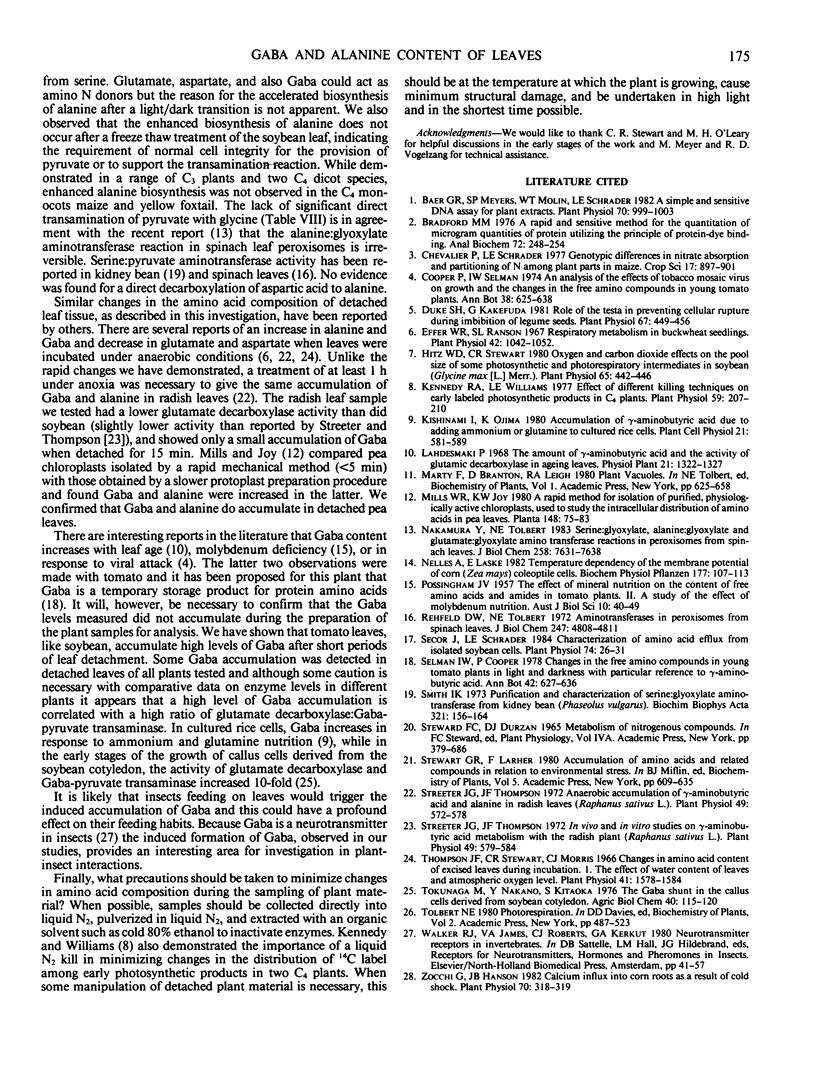Abstract
Soybean (Glycine max [L.] Merr) leaves contain a low level (0.05 micromole per gram fresh weight) of γ-aminobutyric acid (Gaba) but the concentration of this non-protein amino acid increased to 1 to 2 micromoles per gram fresh weight within 5 minutes after transfer of plants or detached leaves from 33°C to 22°C or lower temperatures. A parallel decrease occurred in the concentration of glutamate. Accumulation of Gaba was also triggered by mechanical damage to the soybean leaves, but in plants subjected to a gradual reduction in temperature (2°C per minute) only a small increase in Gaba occurred. A rapid increase in the concentration of alanine and decrease in glycine occurred upon transfer of the soybean plants to darkness and was not influenced by temperature. When plants were returned to normal growing conditions, all changes in amino acid concentrations were fully reversed in 1 hour.
In soybean leaf discs incubated with [14C]glutamate, a rapid accumulation of [14C]Gaba was detected, and glutamate decarboxylase activity of the soybean leaf considerably exceeded (>30-fold) that of Gaba pyruvate transaminase. Part of the transaminase was localized in the mitochondria, but glutamate decarboxylase was not associated with any organelle or membrane component of the leaf cell. We consider that Gaba accumulation results from some change in intracellular compartmentation of the cell triggered by low temperature shock or mechanical damage. The accumulation of alanine due to a light-dark transition could be accounted for by transamination. [14C]Alanine formation was demonstrated when soybean leaf extracts were incubated with glutamate, aspartate, or serine and [14C]pyruvate.
The changes in amino acid concentrations described for soybean leaves were demonstrated for all the vegetative tissues of the soybean plant and at variable rates in the leaves of a range of plant species. The response in detached tomato (Lycopersicon esculentum Mill.) leaves was of a similar magnitude to soybean. Thus, precautions are necessary to minimize changes in amino acid composition induced by manipulation and extraction of plant material.
Full text
PDF





Selected References
These references are in PubMed. This may not be the complete list of references from this article.
- Baer G. R., Meyers S. P., Molin W. T., Schrader L. E. A simple and sensitive DNA assay for plant extracts. Plant Physiol. 1982 Oct;70(4):999–1003. doi: 10.1104/pp.70.4.999. [DOI] [PMC free article] [PubMed] [Google Scholar]
- Bradford M. M. A rapid and sensitive method for the quantitation of microgram quantities of protein utilizing the principle of protein-dye binding. Anal Biochem. 1976 May 7;72:248–254. doi: 10.1006/abio.1976.9999. [DOI] [PubMed] [Google Scholar]
- Duke S. H., Kakefuda G. Role of the testa in preventing cellular rupture during imbibition of legume seeds. Plant Physiol. 1981 Mar;67(3):449–456. doi: 10.1104/pp.67.3.449. [DOI] [PMC free article] [PubMed] [Google Scholar]
- Effer W. R., Ranson S. L. Respiratory metabolism in buckwheat seedlings. Plant Physiol. 1967 Aug;42(8):1042–1052. doi: 10.1104/pp.42.8.1042. [DOI] [PMC free article] [PubMed] [Google Scholar]
- Hitz W. D., Stewart C. R. Oxygen and Carbon Dioxide Effects on the Pool Size of Some Photosynthetic and Photorespiratory Intermediates in Soybean (Glycine max [L.] Merr.). Plant Physiol. 1980 Mar;65(3):442–446. doi: 10.1104/pp.65.3.442. [DOI] [PMC free article] [PubMed] [Google Scholar]
- Kennedy R. A., Williams L. E. Effect of different killing techniques on early labeled photosynthetic products in c(4) plants. Plant Physiol. 1977 Feb;59(2):207–210. doi: 10.1104/pp.59.2.207. [DOI] [PMC free article] [PubMed] [Google Scholar]
- Nakamura Y., Tolbert N. E. Serine: glyoxylate, alanine:glyoxylate, and glutamate:glyoxylate aminotransferase reactions in peroxisomes from spinach leaves. J Biol Chem. 1983 Jun 25;258(12):7631–7638. [PubMed] [Google Scholar]
- Rehfeld D. W., Tolbert N. E. Aminotransferases in peroxisomes from spinach leaves. J Biol Chem. 1972 Aug 10;247(15):4803–4811. [PubMed] [Google Scholar]
- Secor J., Schrader L. E. Characterization of amino Acid efflux from isolated soybean cells. Plant Physiol. 1984 Jan;74(1):26–31. doi: 10.1104/pp.74.1.26. [DOI] [PMC free article] [PubMed] [Google Scholar]
- Smith I. K. Purification and characterization of serine:glyoxylate aminotransferase from kidney bean (Phaseolus vulgaris). Biochim Biophys Acta. 1973 Sep 15;321(1):156–164. doi: 10.1016/0005-2744(73)90069-7. [DOI] [PubMed] [Google Scholar]
- Streeter J. G., Thompson J. F. Anaerobic Accumulation of gamma-Aminobutyric Acid and Alanine in Radish Leaves (Raphanus sativus, L.). Plant Physiol. 1972 Apr;49(4):572–578. doi: 10.1104/pp.49.4.572. [DOI] [PMC free article] [PubMed] [Google Scholar]
- Streeter J. G., Thompson J. F. In Vivo and In Vitro Studies on gamma-Aminobutyric Acid Metabolism with the Radish Plant (Raphanus sativus, L.). Plant Physiol. 1972 Apr;49(4):579–584. doi: 10.1104/pp.49.4.579. [DOI] [PMC free article] [PubMed] [Google Scholar]
- Thompson J. F., Stewart C. R., Morris C. J. Changes in amino Acid content of excised leaves during incubation I. The effect of water content of leaves and atmospheric oxygen level. Plant Physiol. 1966 Dec;41(10):1578–1584. doi: 10.1104/pp.41.10.1578. [DOI] [PMC free article] [PubMed] [Google Scholar]
- Zocchi G., Hanson J. B. Calcium influx into corn roots as a result of cold shock. Plant Physiol. 1982 Jul;70(1):318–319. doi: 10.1104/pp.70.1.318. [DOI] [PMC free article] [PubMed] [Google Scholar]


